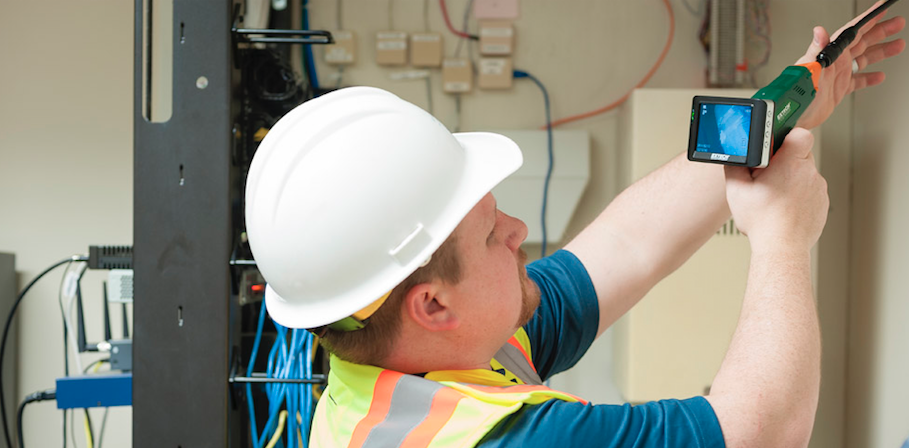One of the biggest criticisms of the LEED process is its claim that using it will help save on operating costs, while in fact, many projects don’t reach that goal. Of course, until a building is completed and systems begin to operate, the owner doesn’t know how much energy the building really uses. Once a building has some history, energy models can be modified to make better projections for the building’s energy consumption. But the owner may not get all the answers if adequate metering systems are not in place to measure the energy loads of the building.
The best way to track sources of energy consumption and verify any savings is to install some type of sub-metering. Before this can be done in existing buildings, the building owner needs to consider the many factors that pour into energy usage and how to track them. This can be done through the process of retrocommissioning, which typically has three phases: planning, investigation, and implementation. It starts with evaluation of the building and its systems which can include heating, ventilation, cooling, electrical, and control and cabling systems.
Retrocommissioning is basically redoing the commissioning process by looking at how the building systems are operating (by installing temporary metering equipment), identifying the optimal performance for equipment and fine tuning everything. This can be quite a challenge since existing buildings may have a variety of equipment that may have been installed at different times. It might mean replacing older or poorly working systems or getting new and old systems working together.
Evaluating options
An energy audit is the first step in determining where building owners want to save money and what they are trying to accomplish. Through a step-by-step process, we look at how energy is being used. Then we identify opportunities for change and work with clients to choose which ones to implement. Our energy audits are done through the multi-level ASHRAE system. Level 1 is a walk-through analysis; Level 2 is the energy survey and analysis; and Level 3 is the detailed analysis with a list of suggested capital modifications. Usually Level 2 is where the core of the work gets done.
THE PROCESS
Retrocommissioning is a method of reviewing existing building operating systems, identifying optimal performance and establishing a step-by-step process for improvement.
• Determine objectives
• Evaluate current systems
• Install monitoring as needed
• Identify optimal performance factors
• Create implementation plan and documentation
This process creates a dashboard for evaluating operating systems and a plan to optimize energy usage. A number of different programs can be set up to monitor what the building is doing so issues can be corrected. Having an information control system in place also means being able to troubleshoot items faster. Part of that means having algorithms built into the building management system. For instance, if there are 20 air handlers running and one of the units starts to operate outside the system set points, the algorithm that continuously reviews the units operation, notifies the facility operator of the issue, so the operator can investigate and take corrective measures.
Another building management system algorithm that is sometimes used can track when people arrive at the building(s) in the morning and set the systems to warm the building(s) up in a more efficient manner. Trying to tweak things like this means learning the behavior of building occupants to optimize programs.
Motion sensors and occupancy control systems can also help and have become very popular. Now, there is a big push to have controls on electric outlets so they will turn off when the building is in unoccupied mode to reduce plug loads. Given the number of outlets in most buildings, this can be a very expensive proposition. As we try to get to net zero, concepts like this can help control what the end user does in the building, but all have a cost that may or may not be offset by energy savings.
Monitoring systems
We find it really comes down to having an engineered systematic approach that involves putting in sub-metering to monitor where the energy is being used for both electric and gas. Every utility has a meter. Sub-metering refers to the monitoring system that is added on specific equipment, systems, processes, or floors. Some clients install extensive sub-metering while others choose a simple one, depending on cost to install and the projected payback.
Tracking energy consumption through sub-metering is currently at a 40-to-60 percent ratio of clients who do and those who do not install sub-metering in their projects. As price per kilowatt hour increases, metering is becoming more prevalent because it gives building owners the information they need to bring down usage costs. The types of buildings most viable for sub-metering include laboratory environments, such as pharmaceutical research and development, data centers, and commercial real estate.
Regional factors
Retrocommissioning and continuously monitoring (commissioning) systems are becoming more attractive in certain geographical areas as well. In the Northeastern United States, for example, it comes down to environment and utility rates. The energy usage is higher and rates are higher in this area, making it much more attractive for building owners to use these programs. In our experience, retrocommissioning has achieved between 30 and 40 percent cost savings.
If an owner can get a rebate for buying new equipment such as a chiller, that can mean additional benefits. New York City has programs that help consumers based on local laws (LLs). This includes LL84 which calls for benchmarking the property; LL85 that deals with energy conservation; LL87 that encourages energy audits when you retrocommission; and LL88 for metering. These laws apply when a building owner goes through the program and applies for rebates related to it. This is just one example of how utility, city, or state programs are proving helpful.
Long-term payback
The benefits of retrocommissioning are ongoing. Upon completion of retrocommissioning, the team identifies low cost and approved items based on their investigation and will work with the client through implementation. This will sometimes include developing a systems manual for all the installed equipment. This manual is used in training the facilities staff to understand the best practices for the operation and maintenance of these new systems.
For owners of existing buildings, retrocommissioning creates a baseline to compare future building energy consumption. Continuously monitoring systems can be installed to maintain the building improved performance and to identity issues faster and more efficiently.
DAVIDE VETTRAINO is Vice President, Regional Business Unit Leader, NV5 Northeast Region in Woburn, MA. He has more than 30 years of experience providing strategic leadership to high-growth organizations and is currently principal-in-charge of the Boston location, responsible for strategic planning, client relationships and professional development. He implements initiatives to improve quality, client satisfaction, and bottom-line financial performance. He can be reached at dvettraino@sebesta.com.
MICHAEL MORRISSEY, LEED AP, BSC is Senior Group Leader, NV5 Northeast region. He has more than 27 years of experience in the engineering field, in design, construction, and commissioning and is a LEED Accredited Professional; NEBB Certified Professional for Building System Commissioning; American Society of Heating, Refrigerating, and Air-Conditioning Engineers (ASHRAE). His specialties include commissioning, LEED consulting and administration, retro-commissioning, TAB (NEBB), O&M operations and support services energy management, HVAC system design, healthcare and lab facilities. He can be reached at mmorrissey@sebesta.com.
Related Stories
Codes and Standards | Feb 20, 2024
AISC, AIA release second part of design assist guidelines for the structural steel industry
The American Institute of Steel Construction and AIA Contract Documents have released the second part of a document intended to provide guidance for three common collaboration strategies.
Student Housing | Feb 19, 2024
UC Law San Francisco’s newest building provides student housing at below-market rental rates
Located in San Francisco’s Tenderloin and Civic Center neighborhoods, UC Law SF’s newest building helps address the city’s housing crisis by providing student housing at below-market rental rates. The $282 million, 365,000-sf facility at 198 McAllister Street enables students to live on campus while also helping to regenerate the neighborhood.
MFPRO+ News | Feb 15, 2024
UL Solutions launches indoor environmental quality verification designation for building construction projects
UL Solutions recently launched UL Verified Healthy Building Mark for New Construction, an indoor environmental quality verification designation for building construction projects.
MFPRO+ News | Feb 15, 2024
Nine states pledge to transition to heat pumps for residential HVAC and water heating
Nine states have signed a joint agreement to accelerate the transition to residential building electrification by significantly expanding heat pump sales to meet heating, cooling, and water heating demand. The Memorandum of Understanding was signed by directors of environmental agencies from California, Colorado, Maine, Maryland, Massachusetts, New Jersey, New York, Oregon, and Rhode Island.
MFPRO+ News | Feb 15, 2024
Oregon, California, Maine among states enacting policies to spur construction of missing middle housing
Although the number of new apartment building units recently reached the highest point in nearly 50 years, construction of duplexes, triplexes, and other buildings of from two to nine units made up just 1% of new housing units built in 2022. A few states have recently enacted new laws to spur more construction of these missing middle housing options.
Hospital Design Trends | Feb 14, 2024
Plans for a massive research hospital in Dallas anticipates need for child healthcare
Children’s Health and the UT Southwestern Medical Center have unveiled their plans for a new $5 billion pediatric health campus and research hospital on more than 33 acres within Dallas’ Southwestern Medical District.
Airports | Feb 13, 2024
New airport terminal by KPF aims to slash curb-to-gate walking time for passengers
The new Terminal A at Zayed International Airport in the United Arab Emirates features an efficient X-shape design with an average curb-to-gate walking time of just 12 minutes. The airport terminal was designed by Kohn Pedersen Fox (KPF), with Arup and Naco as engineering leads.
Codes | Feb 9, 2024
Illinois releases stretch energy code for building construction
Illinois is the latest jurisdiction to release a stretch energy code that provides standards for communities to mandate more efficient building construction. St. Louis, Mo., and a few states, including California, Colorado, and Massachusetts, currently have stretch codes in place.
Giants 400 | Feb 8, 2024
Top 25 Telecommunications Building Engineering Firms for 2023
Alfa Tech Consulting Engineers, Kimley-Horn, Ramboll, and AECOM top BD+C's ranking of the nation's largest telecommunications building engineering and engineering/architecture (EA) firms for 2023, as reported in Building Design+Construction's 2023 Giants 400 Report.
Giants 400 | Feb 8, 2024
Top 40 Performing Arts Center and Concert Venue Engineering Firms for 2023
KPFF Consulting Engineers, Morrison Hershfield, ME Engineers, Thornton Tomasetti, and Arup top BD+C's ranking of the nation's largest performing arts center and concert venue engineering and engineering/architecture (EA) firms for 2023, as reported in Building Design+Construction's 2023 Giants 400 Report.

















